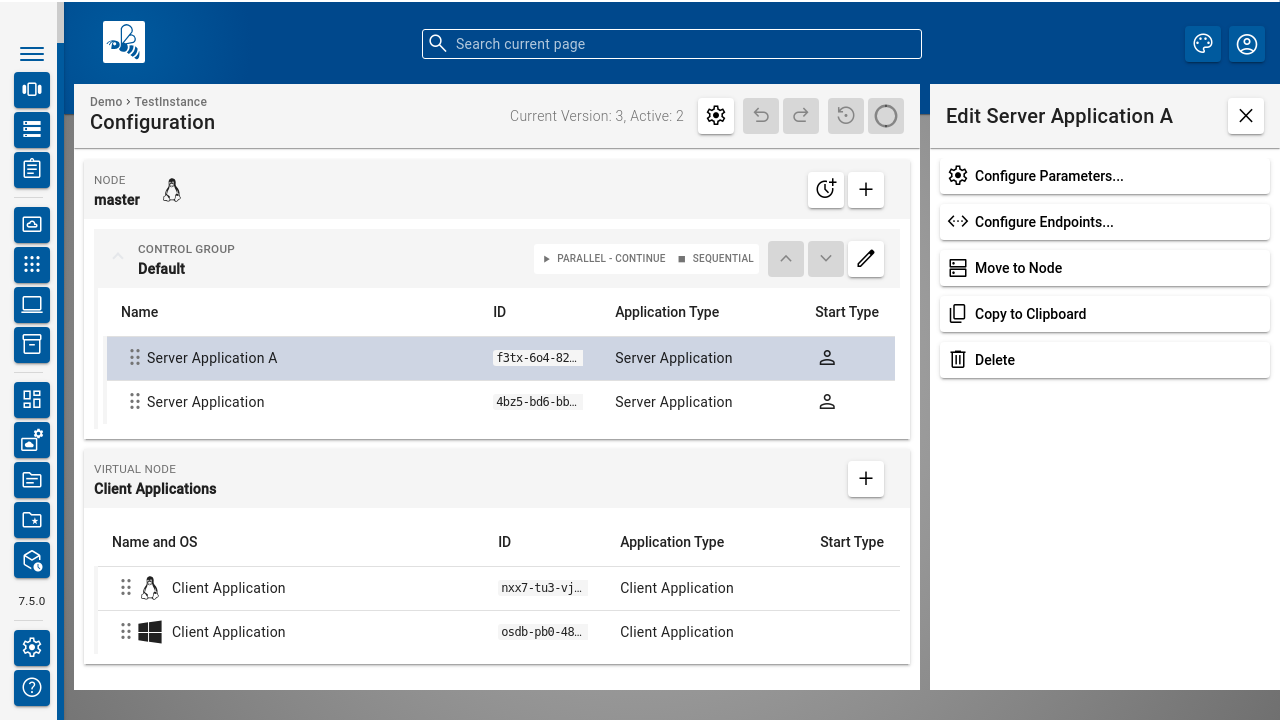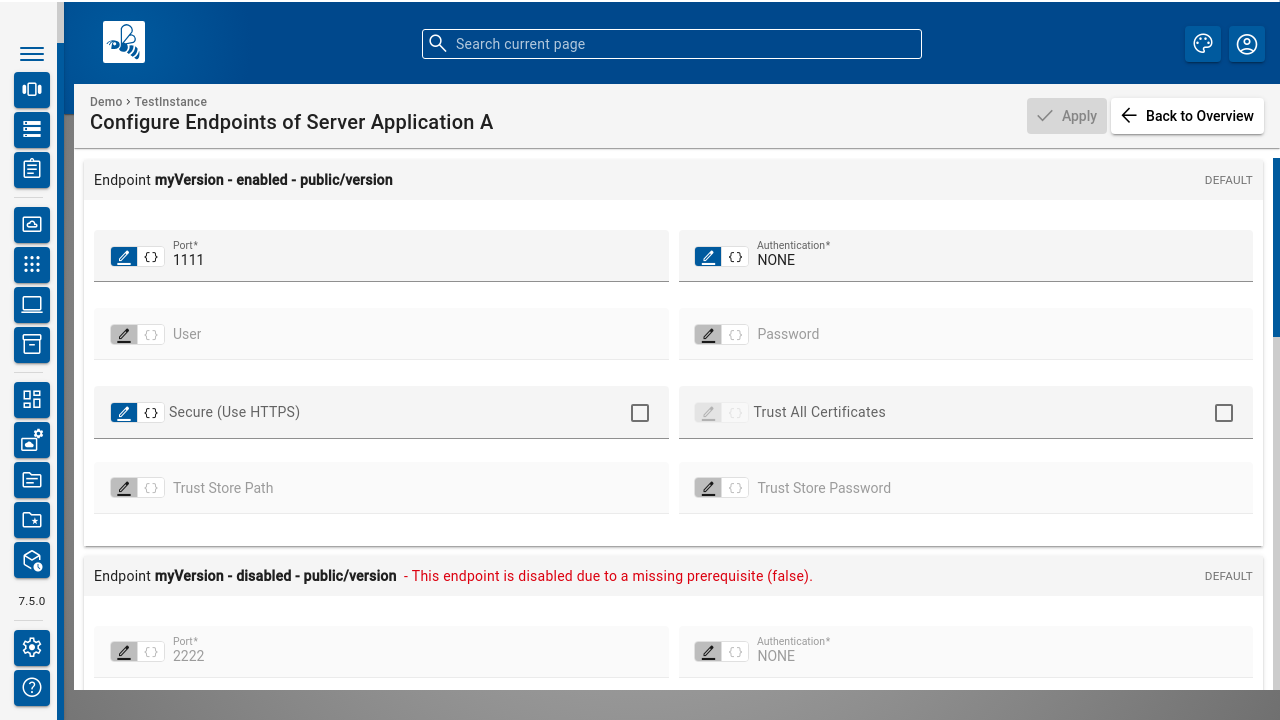#
Endpoint Proxying
BDeploy supports proxying (tunneling) to application endpoints as defined in the app-info.yaml.
The application hosting the endpoint to call can be hosted on any node within the system. As long as this node is attached to a master you can reach (directly in STANDALONE or MANAGED mode, or indirectly in CENTRAL mode), you can tunnel there using BDeploy.
You will need the following information to be able to call an Endpoint of a remote application through the BDeploy public API:
- A BDeploy slim token to be supplied for an authorization header in the form of
X-BDeploy-Authorization: Bearer <TOKEN>. You can obtain this token from the Web UI for the logged in user. - The
IDof the instance group hosting the application you want to tunnel to. - The
IDof the instance hosting the application you want to tunnel to. You can see this ID for instance from the browser's URL when on the instance overview page for the instance in question. - The
IDof the application's endpoint as defined in the app-info.yaml. - The
IDof the application which hosts the endpoint identified by the endpointIDabove.
A typical proxy call using the public API would look like this, when using cURL:
curl -k -L -H "Accept: */*" \
-H "X-BDeploy-Authorization: Bearer <X>" \ <1>
"https://server/api/public/v1/common/proxy/myEndpoint?BDeploy_group=MyGroup&BDeploy_instance=xxxx-111-xxxx&BDeploy_application=yyyy-111-yyyy" <2> <3> <4> <5> <6><X>is a bearer token, which can be obtained from the Web UI (User drop-down menu).serveris the hostname (and port) of the BDeploy master. This may be either aCENTRAL,MANAGEDorSTANDALONEserver, being in charge (directly or indirectly) of the application to tunnel to.myEndpointis theIDof the endpoint to call as defined in the app-info.yaml of the hosting application.MyGroupis theIDof the instance group which hosts the application to tunnel to.xxxx-111-xxxxis theIDof the instance which hosts the application to tunnel to.yyyy-111-yyyyis theIDof the application which hosts an endpoint with the given endpointID.
#
Obtaining required IDs
There are two ways to obtain required IDs. You can use a purely manual approach and for example deduce ID's from URLs and the Web UI itself. Or you can use the public API to query BDeploy for available objects.
http://my-server/#/instances/dashboard/MyGroup/xxxx-111-xxxxFrom the above URL, you can find the instance group ID (MyGroup) as well as the instance ID (xxxx-111-xxxx). When on the instance dashboard, click the server application you want to tunnel to. The process control panel for that application opens up, and you will see the application's process ID displayed.
Last thing to manually lookup is the endpoint ID. Endpoints can be accessed on the instance configuration page by clicking on the application you want to tunnel to and then clicking on [ Configure Endpoints ]

You will be able to read the endpoint ID and configured properties of the endpoint on this page. The configuration will be used by BDeploy when instructed remotely to call that endpoint. BDeploy will take care of things like authentication, security, etc. The actual caller will only require access (and permissions) on the master server they are calling into, not to the actual application. Instead, BDeploy itself is configured to be authorized to perform the call.

For automatic lookup, you can use the following BDeploy public API endpoints. Those are provided by the master server, same as the actual proxy endpoint:
# will list instance groups
curl -k -H "Accept: application/json" \
-H "X-BDeploy-Authorization: Bearer <X>" \ <1>
"https://server/api/public/v1/instanceGroups"
# will fetch the latest configuration of all instances in an instance group
curl -k -H "Accept: application/json" \
-H "X-BDeploy-Authorization: Bearer <X>" \
"https://server/api/public/v1/common/instances?BDeploy_group=MyGroup&latest=true" <2>
# will fetch all endpoints exposed by a certain instance along with the ids of the applications hosting them.
curl -k -H "Accept: application/json" \
-H "X-BDeploy-Authorization: Bearer <X>" \
"https://server/api/public/v1/common/endpoints?BDeploy_group=MyGroup&BDeploy_instance=xxxx-111-xxxx" <2> <3><X>in the following cURL calls is the bearer token as obtained from the Web UI.MyGroupis the name of one of the instance groups as obtained by the first API. You can fetch theIDof each instance from the returned JSON.xxxx-111-xxxxis theinstance IDas obtained by the second API. The returned JSON will include theapplication IDhosting the endpoint along with the actual specific configuration of that endpoint (including itsID).
#
Authentication
There are several different ways to authenticate the application at the endpoint. Those authentication methods are explained below.
#
NONE
No authentication information will be provided.
#
BASIC
Authentication is done by sending a username and a password to the endpoint in plain text. The username and password must be provided by the user.
#
DIGEST
Authentication is done by sending a digest workflow. The username and password must be provided by the user.
#
OIDC
Allows configuration of an Open ID Connect workflow. Selecting this authentication method displays these new input fields:
#
UI Endpoints
UI Endpoints can be defined to allow simple access to hosted web applications in a similar manner to client applications. This means that BDeploy will provide a link to the web application in much the same way as it provides access to client applications in its own UI, both on the (server) process status panel, as well as on the client applications page.
Note
The permission to access a UI endpoint through the BDeploy UI is CLIENT.
A sample UI endpoint definition may look something like this in the app-info.yaml:
endpoints:
http:
- id: "appUi"
enabled: "{{V:port-param}}"
path: "/"
contextPath: "/appUi"
port: "8080"
secure: false
authType: NONE
type: UI
proxying: trueNote
The difference between path and contextPath is that while path defines the root of the server hosting the application, contextPath may be used to add more path segments to the link generated by BDeploy which leads to the application entry point. The contextPath is used only to determine the address to open when the application is opened through BDeploy.
The enabled flag controls whether the endpoint is configured and visible to the end user. The expression is evaluated against the current configuration, and the endpoint is hidden in case the enabled condition evaluates to null, empty, false or cannot be resolved at all.
#
UI Endpoint Proxying
Much like "normal" proxying attribute on the endpoint. A UI endpoint will be reachable on any participating BDeploy server (STANDALONE only or CENTRAL and MANAGED if used). BDeploy handles all the traffic from and to the actual web application. There is no direct access to the actual application required.
Note
This feature is intended for simple use cases. Advanced use cases may not work as expected (e.g. WebSockets). BDeploy uses a simple request/response wrapping internally to forward requests and is not a full HTTP proxy.
Note
Only users which are logged in to BDeploy can access UI endpoints via the proxy mechanism.

